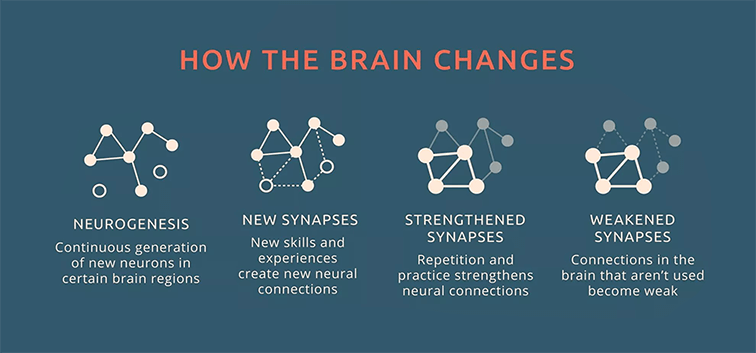Are you a half-full or a half-empty glass kind of person?
Positive thinking can be a powerful tool for improving mental health and overall well-being.
Sure, the idea that focusing on good thoughts and positive outcomes can change the way we feel sounds more like common sense than anything else.
But I’d say it’s one of those “easier said than done” things when you try to actually implement it in real life.
In this post, we’ll explore the science behind positive thinking, and I’ll give you some tips and techniques for incorporating more positive thinking into your daily routine whether you need to boost your mood, reduce stress, or simply live a happier life.
What is Positive Thinking? Let’s define it
Positive thinking is simply the practice of focusing on good thoughts and positive outcomes. It’s about looking for the best in every situation and seeing the good in every person.
Yup, nothing but changing the way you think about yourself and the world around you.
But there is more to it because this can affect our emotions and actions. We’ll talk about this in a second.
When you think positively, you tend to feel better and are more likely to take positive actions. On the other hand, when you think in a negative way, you feel worse and are more likely to end up engaging in negative behaviors.
That’s why positive thinking is key to improving your mental health.
What positive thinking is NOT
I think the reason we sometimes have to make a clear distinction here is that there is a very fine line between what positive thinking is and what is NOT.
Let me explain…
Avoidance
Positive thinking doesn’t mean being happy all the time or pretending your problems don’t exist. It’s about recognizing that even in difficult situations, there is something to be learned and something to be grateful for. It’s about trying to see the best in every situation.
You can’t live your life trying to avoid difficult emotions.
Negative emotions will still be part of your life, but you have to make the conscious decision to focus on the positive aspects of any situation, so you can change your perspective.
Toxic Motivation
The problem with toxic motivation is that it is fueled by negative emotions like fear, shame, and guilt, so you’re most likely headed to end up with feelings of anxiety, stress, and burnout.
For example, a person running on toxic motivation may be working excessively out of fear of losing their job, you can imagine how easy it would be for this situation to drive anybody to negative behavior.
In contrast, a person motivated by positive thinking may go about their day fueled by excitement and inspiration, instead of fear and shame.
Benefits of positive thinking for mental health
So far, sounds like common sense, right? But, how exactly is this business of positive thinking improving your mental health?
Here are some examples…
- Less Stress: Shift your focus from worries to positive thoughts and solutions to help lower levels of the stress hormone cortisol, definitely improving your mental health
- Better mood: Feel-good chemicals like serotonin and dopamine in your brain can lead to feelings of happiness and well-being
- Increased resilience: Learn how to bounce back faster from difficult situations by seeing challenges as opportunities for growth. This can help reduce stress
- Physical health: Positive thinking has been linked to better physical health, including lower blood pressure, a stronger immune system, and improved heart health
- Better relationships: It can also help you have more positive interactions with others, which can improve relationships and your social life in general
- Increased productivity: Motivation, focus, and productivity can help you achieve your goals more effectively
Look, this isn’t magic, positive thinking doesn’t have a switch. It doesn’t replace professional help either, but it is definitely a tool you can use to improve your mental health and well-being.
And of course, even better when you combine positive thoughts with other essential habits like exercising and eating healthy, right?
The link between thoughts and emotions

Let’s go back to the idea that thoughts can affect emotions and actions because this link is a fundamental principle of positive thinking.
Let’s say you have a negative thought, like…
“I’m not good enough”
A negative emotion is created: Fear, insecurity, low self-esteem.
This triggers a negative behavior: Procrastination, avoidance, self-sabotage.
The rest is history: No “small-win-feeling” at the end of the day for you.
But the grass is greener on the other side of the fence.
A positive thought, say…
“I am capable”
Will most likely trigger a positive emotion: Confidence, motivation, self-esteem.
And result in a completely different behavior: Taking action, and achieving goals.
This link between thoughts and emotions is known as Cognitive Behavioral Theory and it is based on the idea that, if you change the way you think, you can change the way you feel.
Too simple?
Well, don’t forget that your thoughts are not just random shooting starts, they are actually based on your beliefs, values, and experiences. Identifying and challenging these might not exactly be a walk in the park at the beginning.
How positive thinking affects the brain and body
We mentioned serotonin and dopamine before, the chemicals in charge of providing happy feelings in your brain when you have positive thoughts.
Well, these chemicals can also improve brain functions like memory and learning.
Say hello to Neuroplasticity.
Your brain has the ability to change and adapt based on experiences and the environment by creating new neural pathways, which can improve cognitive function.

Positive thinking can also have a positive impact on the body, in very specific ways actually…
- Lower blood pressure
- Improved heart health
- Stronger immune system
And there is an explanation too: Cortisol. The stress hormone.
Cortisol is a hormone associated with negative health effects such as high blood pressure and weakened immunity.
But, as the Journal of Behavioral Medicine points out, positive thinking can significantly reduce your Cortisol production.
So…
Feel-good chemicals + Neuroplasticity + Positive thinking = Improved mood and cognitive function.
Less stress + Healthy behaviors + Positive thinking = Improved physical health.
How Positive Thinking improves your Mental Health
Okay, now that we have a clear understanding of what positive thinking is and what is not, let’s talk about how to actually make this happen for yourself.
I mean, in real life.
Identify and challenge negative thoughts
Negative thoughts can show up at any time. They can be pretty automatic and habitual, in some cases with more frequency.
Most importantly, changing them can be difficult at times.
But, how do you stop them?
How are you supposed to shut down an entire lane in this information superhighway located inside your head?
Let’s talk about identifying and challenging negative thoughts.
Recognize negative thoughts
The idea of having enough awareness to catch a thought in mid-air brings back memories of Mr. Myagi catching flies with chopsticks.

It does need practice, but I can guarantee you it’s not that much.
Pay attention to your thoughts throughout the day and take note of any negative thoughts that come up.
Challenge the thought
Once a negative thought has been identified, ask yourself:
- If it’s true
- Do you have evidence to support the thought or is it just an assumption?
- Is there a different point of view in this situation?
If you haven’t noticed, you are basically taking all the power away from the thought.
You don’t need to share or report this to anybody. I do recommend making a note, putting this stuff on paper has magical powers.
Replace the thought
You’ve identified the thought, challenged it, and is now weaker than before.
Time to replace it with a positive one.
“I’m not good enough”
Is replaced with “I’m doing the best I can.”
Did you notice that I didn’t replace it with something like “I’m the best there is in the universe”? That’s because it is important that your mind feels this is a realistic thought.
Practicing gratitude and mindfulness
Gratitude is the practice of being thankful for the good things in your life and it can be a great way to incorporate positive thinking in your life.
It is important because it can help you shift your focus from what’s missing to what you already have. Focusing on the good things in your life will help you feel more positive.
A few ways you can practice gratitude:
- Keep a Gratitude Journal: Write down 3 things you’re grateful for each and every day. It could be something small, like a cup of coffee, or big, like the love of your family
- Share your gratitude: Tell someone you’re grateful for them. A simple thank you note or phone call can go a long way in making someone feel appreciated
- Reflect on past blessings: Take a moment to reflect on the things you’ve been blessed with in the past. Think about how far you’ve come and all the good things that have happened to you
Get the Three Good Things exercise.
Setting and achieving positive goals
Achieving positive goals is also important to incorporate more positive thinking in your life because they give you a sense of purpose and accomplishment.
But not all goals are created equal.
Here are a few tips for setting up positive goals:
- Be specific: Define goals clearly. Don’t just say “I wanna lose weight” without any specifics like a time period or how much weight. Say “I want to lose 15 pounds in 3 months.”
- Be realistic: Goals should be realistically achievable. Don’t set goals that are too challenging, set yourself up for success.
- Be positive: Frame goals in a positive way. Don’t say “I want to stop procrastinating,” say something like “I want to start working on my projects as soon as they are assigned.”
- Break down goals: Small wins, baby. Break down large goals into smaller, more manageable steps. Don’t lose motivation on goals that are too long-term.
- Track progress: Make it easy to keep track of your progress. This will also help you stay motivated and not lose track.
- Celebrate milestones: Make sure you celebrate every win. Celebrating your achievements, no matter how big or small will help you stay positive.
- Be flexible: Don’t be afraid of adjusting your goals at any point if needed. Life happens, some stuff is out of your hands and sometimes those goals also need to be adjusted accordingly.
Remember that the key is to set positive, realistic, specific goals and keep your focus on reaching them.
Surrounding yourself with positive influences
Surrounding yourself with positive influences is an important step in incorporating positive thinking. The people you surround yourself with can have a big influence on your thoughts and emotions.
Here are a few tips for surrounding yourself with positive influences:
- Seek out positive people: Spend time with people who are positive and supportive. They will lift your mood and help you see the best in yourself
- Join positive groups: Join a club that shares your interests and values. This connects you to like-minded people and gives you a sense of belonging
- Limit exposure to negative influences: Limit the time you spend with people that you know will bring your energy down or leave you with a negative vibe for the rest of the day
- Seek out role models: Look for role models who inspire you and individuals you admire. They can be a constant source of inspiration
- Positive self-talk: Surround yourself with positive thoughts and words. The power behind language is huge, even when you talk to yourself
The people you surround yourself with have a big impact on your thoughts and emotions, so choose wisely. Not just anybody should have that kind of influence on how you feel or what kind of day you have ahead of you.
Let’s explore this a bit deeper…
Positive affirmations and visualization
Positive affirmations are statements that you repeat to yourself to help change the way you think and feel about yourself.
For example “I am strong,” “I am capable,” and “I am worthy.”
Here are a few tips for using positive affirmations:
- Make them specific: Don’t be vague. Affirmations should be specific to your situation
- Make them present tense: Affirmations should be stated in the present tense as if they are already true
- Repeat them regularly: Repeat your affirmations as often as possible, make it a daily habit
- Believe them: Believe in your affirmations and trust that they will come true. If you don’t, you should not expect any positive outcomes
Visualization is the practice of creating mental images for a desired outcome. It helps you see yourself achieving your goals and can increase your confidence.
How to use visualization:
- Set a specific goal: Decide on a specific goal that you want to achieve
- Create a vivid mental image: Create a mental image of yourself achieving your goal. Be as detailed as you can
- Include emotions: Include emotions in your visualizations. Imagine the feeling when you achieve your goal
- Repeat the visualization: Again, do it as often as possible, on a daily basis if possible
- Take action: Take action toward your goal after visualizing it
Positive affirmations and visualization are powerful tools for shifting your focus from negative thoughts to positive ones and can help you achieve your goals.
Seek support
Sometimes it’s harder to challenge negative thinking on your own.
You also have to understand that this can affect folks on different levels, you might be able to handle things a little easier than the next person or the other way around. If you feel you need help getting started, don’t hesitate to seek support with your coach, in therapy, or in a support group.
Conclusion
In conclusion, positive thinking is a powerful tool for improving mental and physical health, achieving our goals, and living a more fulfilling life. It’s not just a concept, but something that can be practiced and applied in real life.
And remember, this is a habit that needs to be practiced and developed over time, and it may not come naturally to everyone.
But you can start practicing right now.
How do YOU practice positive thinking in your life?
Image credits: Keira Burton, Andrea Piacquadio. Infographic by: nicabm.






0 Comments